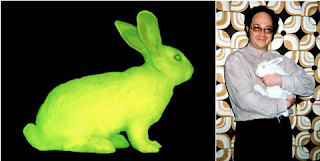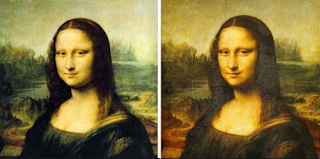Week 6: BioTech + Art
Biotechnology
art is one of the most controversial art forms on this planet because of the
amount of animal testing and genetically alternation it involves. Victoria
Vesna highlights a few of these artist in her first three lectures. In her
first lecture, she introduces Eduardo Kac and his art work involving his rabbit
Aba. In his experiments, he would inject the genes of Alba with a fluorescent jelly
fish in a process he named zygote micro injection. While there was no harm Alba,
I believe this is an unethical way to produce art. Animals are not meant to be
in labs, and do not have a say if they condone the activity they are undergoing.
While the bunnies did not seem to be uncomfortable or in pain, there is no way
for them to communicate it if they were.
Eduardo
Kac was just an individual Biotech artist, and while his work was controversial,
it led to many more people to follow in his footsteps. In lecture two Vitoria
Vesna introduces us to the organization named Symbiotic. This organization gives
its biotechnical artist a place and the freedom to work on their art. Many of
their artist produce unique art pieces, but most of them involve different types
of insects or animals. For example, Marta De Menezes is famous for her work
with modifying the wing patterns of live butterflies. Menezes would put
different size holes in different prats of the winger of these butterflies and
see how it affected their flight pattern. Again, I am against this practice because
it involves a living being, and there is no way to tell is the creature is
being hurt. Whether putting holes in the wings of butterflies is harmful or
not, it is unnatural and should not be done.
Courtesy of: Marta de Menezes. “Nature?” Live Bicyclus anynana butterfly
with modified wing pattern, 2000.
While
there have been many artist who have brought a negative image to biotech art,
there have also been many who have used it in the correct way. For example,
George Gessert introduced in lecture 3 was a photographer who was fascinated with
breeding plants as an art form. His work was inspired by Edwards Steichen who
was also a photographer who bread flowers. Gessert coined his term Genetic Folk
Art, and you can still see people using his ideas today. In lecture 3 Vesna
talks about a woman named Kathy High. I am torn between Kathy High’s art
because in some of her past work, she has used rats to test what sounds create
stress for rats. While this made, me frustrated, her work moved away from using
animals, and her most recent work was a project she created called blood wars.
In this project, Kathy observes how different immune systems compete against
each other using white blood cells. Both of these artists have demonstrated how
you can use biotech art as a positive without harming others, and without
bringing unnatural elements into the experiment.
Courtesy of: Flower- https://kingkati.wordpress.com/2012/09/05/examining-the-hybridization-of-irises-by-george-gessert/
Vesna,
Victoria. “Biotechnology and Art Part 1” 1280x720." YouTube. UC Online Program, 18
Sept. 2013. Web. 08 May 2016.
<https://www.youtube.com/watch?v=PaThVnA1kyg>.
Vesna,
Victoria. "Biotechnology and Art Part 2." Uc Online Program, 17 Mar.
2012. Web. <https://www.youtube.com/watch?v=PaThVnA1kyg>.
Vesna,
Victoria. "Biotechnology and Art Part 3." YouTube. UC Online Program, 17
May 2012. Web. 08 May 2016.
<https://www.youtube.com/watch?list=PL9DBF43664EAC8BC7&v=3EpD3np1S2g>.
Vesna,
Victoria. "Biotechnology and Art Part 4." YouTube. UC Online Program, 17
May 2012. Web. 08 May 2016.
<https://www.youtube.com/watch?list=PL9DBF43664EAC8BC7&v=2qSc72u9KhI>
Vesna,
Victoria. "Biotechnology and Art Part 5." YouTube. UC Online Program, 17
May 2012. Web. 08 May 2016. <https://www.youtube.com/watch?list=PL9DBF43664EAC8BC7&v=z7zHIdsFS3A>.






I enjoyed reading your blog post! I agree that using live animals for biotech art is unethical without their consent. On the other hand, these controversial art projects also pioneered new expressions of BioArt that have positive results without relying on harmful practices. As technology continues to improve and expand, I think society's ethics will inevitably adjust to current needs. This is why I feel that it is both difficult and important to distinguish the meanings of natural and ethical. Overall, the most valuable results from biotech art are allowing more understanding among different professions and providing a new perspective on the evolving world of art and technology!
ReplyDeleteThis is true that what you said "Animals are not meant to be in labs." Such the behavior is so unethical for any of animals that people use them to do researches or activities since they are not able to be communicated. For me, it is kind of the case of murder that the change of genetic structure and the mutation of cells will be changing or reducing their lifestyle and lifetime. However, Kac has given great contributions still. Anyway, the key point of bio-tech and art is referred by Kevin that "the most valuable results from biotech art are allowing more understanding among different professions and providing a new perspective on the evolving world of art and technology!"
ReplyDeleteI share the same view with you about the holes on the butterflies. It is quite unreasonable. Even though the shinning rabbit looks cool, but just as you said, the bunny couldn't communicate and it may suffer from the chemical material. Art should be based on caring for animals.
ReplyDeleteI think it's such a good point that animals do not even have the opportunity to voice against being tested on. Alba is an excellent example of an animal being removed from the safety and security of her natural life and being displaced due to the somewhat selfish experiments of Kac. Kac was impressive in his work done, but it is heartbreaking to see the value of an animal life de-empowered by their lack of vocal power.
ReplyDelete